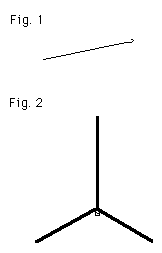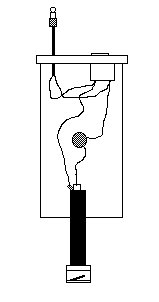
Buying Scanner Antennas
The reception on a scanner is only as good as the antenna attached to it. The "rubber ducky" antennas that come with portable scanners receive 800 MHz trunking band transmissions very well but when it comes to other lower frequency bands such as cordless phones, fast food drive thru windows, etc. they leave a lot to be desired. Metal whip antennas that come with base scanners do a good job on cordless phone and all other frequency bands. Whip antennas can be purchased for portable scanners but because of their longer length whip antennas don't give you the convenience that you get from a "rubber ducky" antenna. With a "rubber ducky" antenna and a portable scanner hidden away in a back pack or any other kind of bag and pair of headphones you can hear the security guards when you take a trip to your local mall.
For the best reception when you are listening to the scanner at home an outdoor antenna is the only way to go. Roof mounted antennas for scanners come in all shapes and sizes. One of the most common of the roof mounted antennas is the ground plane. These antennas consist of one element that sticks straight up into the air and three or four elements that point outward or downward on a slight angle. The reception from a ground plane antenna is usually very good and they don't cost that much (around 40 dollars) most of these include a mounting kit so that you can put it up your self.
Another kind of antenna is the discone antenna. These antennas consist of one element that sticks straight up with eight or ten short elements that stick straight out and eight or ten longer elements that stick downward at an angle. These antennas are usually quite expensive (around 150-200 dollars) and are only used for monitoring space craft such as the space shuttle and the Mir space station. These can only be heard providing that you live directly under the orbits of these space craft your antenna is strong enough and high enough off the ground and that you have a signal amplifier.
Another issue that you need to take into consideration when putting up a roof mounted scanner antenna is the cost of hooking up the antenna to the scanner. 1/4 inch 75 ohm TV cable should not be used for lengths over fifteen feet because loss in signal can occur. The best choice for antenna cable to use is 1/2 inch 52 ohm cable. The cost for using this kind of cable is high but the staff at your local electronics store will be able to help you to find the best antenna cable for you.
For apartment dwellers a roof antenna is most probably out of the question and leaving few other options. however taping a metal whip antenna into the window is the most desirable. However if your apartment has a balcony then a smaller version of the ground plane can be used.

Coat hanger groundplane antenna
Get a chassis mount SO-239 jack, a coat hanger or two, coax cable with the right connectors for the antenna and the scanner.
cut the coat hangers into five equal lengths of 18 inches each. Clean one end of one of the lengths and solder it to the centre connection of the SO-239 connector (not the end with the threads) Take each of the last 4 lengths, make a small loop on one end and bend that end so that it forms a 120 degree angle, see fig. 1 take each these lengths and attach them to the corner holes of the SO-239 connector with a small nut and a bolt. Your finished antenna should look like figure 2

Undercover Antenna
If you have ever looked at a walkman and wondered what it uses to pull the FM
radio signals out of the air? It's actually the headphone cord that is used by the
walkman as an antenna. You can do the same for your scanner. What you need is a used film canister,
a 0.1 microfarad ceramic disc capacitor, a short length of audio cable,
an 1/8th inch plug (to go into the scanner's earphone jack), 1/8th inch mini jack (for your earphone),
and a short length of coax cable with the right connector for your scanner.
To build the undercover antenna you first poke two holes in the lid of the film canister one for the
audio cable with the 1/8th mini plug soldered to the end and the other for the 1/8th mini jack.
Next poke a hole in the bottom of the film canister for the coax cable with scanner antenna plug on the other end.
Strip the insulation off the coax cable so that both the inner and outer conductors are showing.
Solder the capacitor to inner conductor of the coax cable.
Solder the other pin of the capacitor and the center conductor of the audio cable to the to the centre pin of 1/8th inch mini jack.
Solder the outer conductors of the audio cable and the coax
cable to the outer pin of 1/8th inch mini jack. To use the undercover antenna,
connect the antenna connector to the antenna jack of your scanner, hook up the mini plug to the earphone jack and
connect the earphone to the mini jack. You are using your earphone cord as an antenna.
This kind of antenna work a lot better than the "rubber ducky"
antennas the come with portable scanners.

Twin Lead wire J-pole antenna
This is a simple antenna constructed from 300 ohm twin lead tv antenna wire and coax cable. You will need a forty eight inch length of twin lead wire. Take one end of the twin lead wire and strip off a quarter of an inch of the wire insulation. Next measure twelve inches from the end where you stripped off the wire insulation and cut a notch through right side of the twin lead wire including the right side wire. Next strip off an end of the coax cable so that a quarter of an inch of the inner conductor is showing. Solder the inner conductor of the coax cable to the left lead wire from the twin lead and carefully tape up this connection. Solder the right lead wire to the outer braided wire on the coax cable and then tape up the whole works. Attach the connector right for attaching the antenna to your scanner. Tape the twin lead end up in a window and now you have an antenna that will give you good reception on all frequency bands.
Accessories|
Issues|Questions|Frequencies|
Links|Tips|
Antenna
|jargon|clubs
Return to Main page



